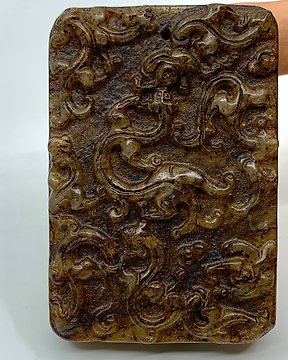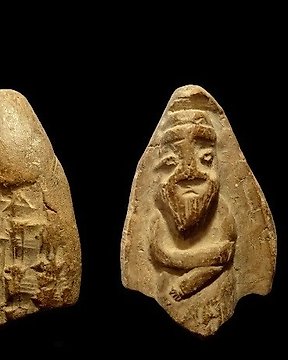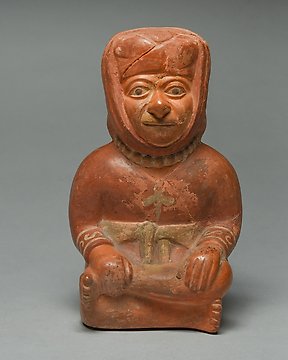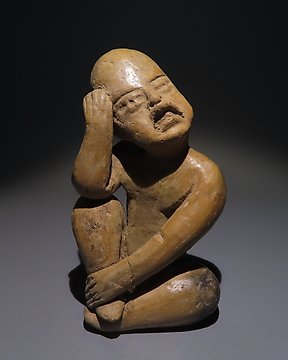All OK and with very fast shipping.
Übersetzung ansehenAltchinesisch Töpferware Sichuan. Hofkonkubine. 57,5 cm H. Han-Dynastie, ca. 206 v. Chr. – 220 n. Chr.
Nr. 84871211
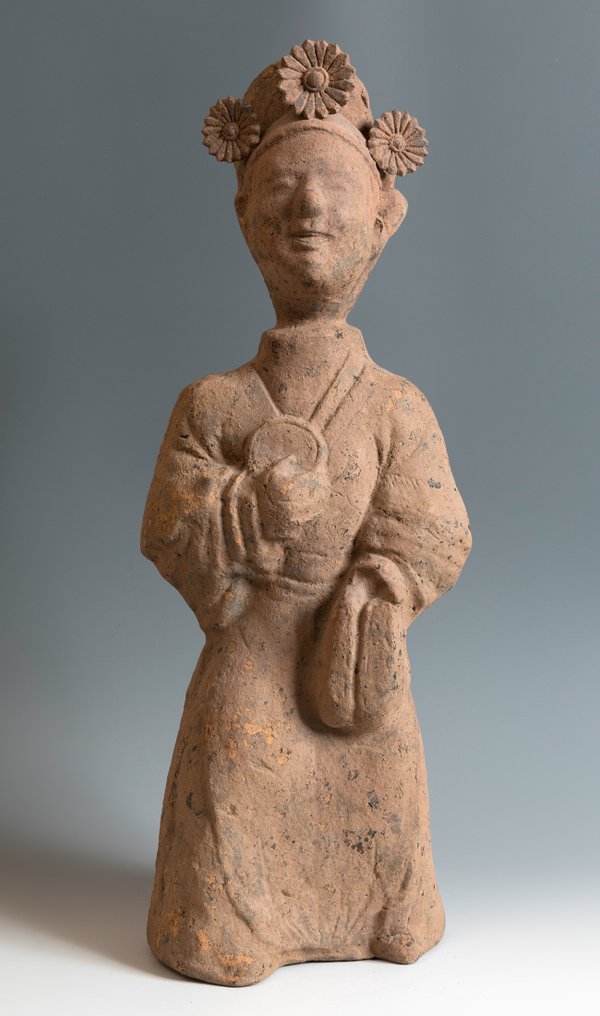

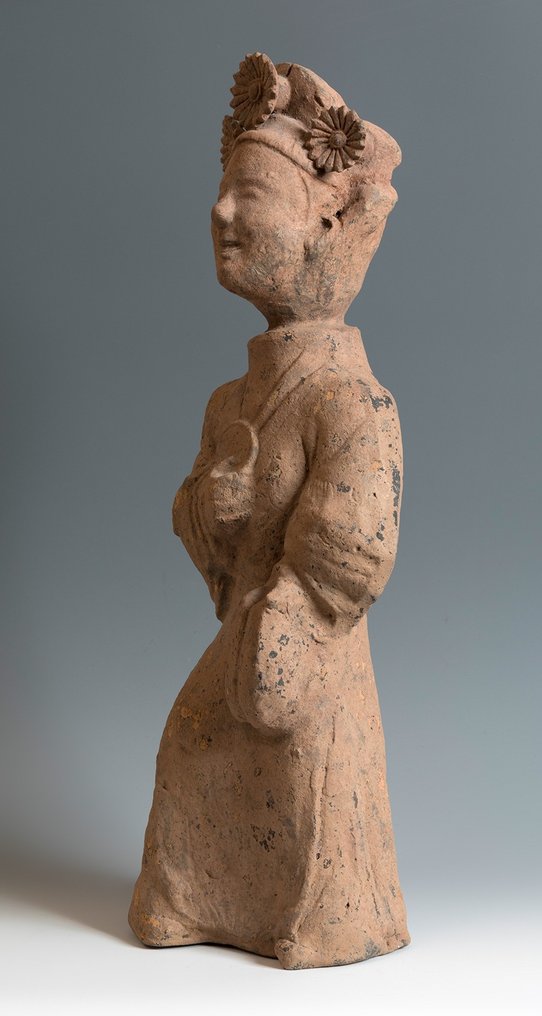
Sichuan. Court concubine.
57.5 cm H.
Ancient Chinese
Han Dynasty, Circa 206 BC - 220 AD
Pottery
PROVENANCE: Private collection, Paris, France, 1970.
CONDITION: Intact.
The art of the Han dynasty (206 BCE - 220 CE) of ancient China is characterised by a new desire to represent everyday life and the stories from history and mythology familiar to all. The arts were fuelled both by a political stability with its consequent economic prosperity and the development and highly successful combination of brushes, ink, and paper. Calligraphy, painting, lacquerware production, and jade carving were just some of the areas Han artists pushed forward the boundaries of what was possible to make technically and what was desired aesthetically by the ever-increasing number of art connoisseurs.
Large figure sculptures are rare from the Han period, but there are some statues representing generals and officials which were stood outside their tombs. Smaller-scale works include cast bronze sculptures of horses which are common in 2nd-century CE Han tombs. These are usually depicted in full gallop with only one hoof resting on the base so that they almost appear to be flying.
Painted earthenware figurines of single standing women, men, and servants are common. Cast bronze was used to make small figurines and ornate incense burners. These were often inlaid with gold and silver or gilded. One superb piece is a gilded bronze oil-lamp in the form of a kneeling servant girl, which dates to the late 2nd century BCE.
Jade was especially esteemed for its rarity, durability, purity, and certain mystical qualities. The material was carved into all manner of animals, people, and mythical creatures. Han Jade carvers now used circular cutting drills and iron tools, but pieces often have a lower quality finish than previously, which suggests they were starting to be made quicker and on a larger scale of production. Another feature of Han jade sculpture is the use of flaws and impurities in the jade to make them part of the sculpture. From the 1st century BCE, a pure white jade became available from central Asia following the expansion of the Han empire.
One unique but stunning art form was the creation of jade 'suits' to cover the body of the deceased in royal tombs. The 'suits' cover the contours of the body and are made from up to two thousand individually carved rectangular pieces of jade stitched together using gold or silver wire. Two outstanding examples come from the late 2nd century BCE tomb of Prince Liu Sheng and Princess Dou Wan at Mancheng. Reserved only for royalty, they nevertheless became so costly to produce that later rulers banned their use.
Notes:
The seller guarantees that he acquired this piece according to all national and international laws related to the ownership of cultural property. Provenance statement seen by Catawiki.
The piece includes authenticity certificate.
The piece includes Spanish Export License.
#theaterasia
Der Verkäufer stellt sich vor
Sichuan. Court concubine.
57.5 cm H.
Ancient Chinese
Han Dynasty, Circa 206 BC - 220 AD
Pottery
PROVENANCE: Private collection, Paris, France, 1970.
CONDITION: Intact.
The art of the Han dynasty (206 BCE - 220 CE) of ancient China is characterised by a new desire to represent everyday life and the stories from history and mythology familiar to all. The arts were fuelled both by a political stability with its consequent economic prosperity and the development and highly successful combination of brushes, ink, and paper. Calligraphy, painting, lacquerware production, and jade carving were just some of the areas Han artists pushed forward the boundaries of what was possible to make technically and what was desired aesthetically by the ever-increasing number of art connoisseurs.
Large figure sculptures are rare from the Han period, but there are some statues representing generals and officials which were stood outside their tombs. Smaller-scale works include cast bronze sculptures of horses which are common in 2nd-century CE Han tombs. These are usually depicted in full gallop with only one hoof resting on the base so that they almost appear to be flying.
Painted earthenware figurines of single standing women, men, and servants are common. Cast bronze was used to make small figurines and ornate incense burners. These were often inlaid with gold and silver or gilded. One superb piece is a gilded bronze oil-lamp in the form of a kneeling servant girl, which dates to the late 2nd century BCE.
Jade was especially esteemed for its rarity, durability, purity, and certain mystical qualities. The material was carved into all manner of animals, people, and mythical creatures. Han Jade carvers now used circular cutting drills and iron tools, but pieces often have a lower quality finish than previously, which suggests they were starting to be made quicker and on a larger scale of production. Another feature of Han jade sculpture is the use of flaws and impurities in the jade to make them part of the sculpture. From the 1st century BCE, a pure white jade became available from central Asia following the expansion of the Han empire.
One unique but stunning art form was the creation of jade 'suits' to cover the body of the deceased in royal tombs. The 'suits' cover the contours of the body and are made from up to two thousand individually carved rectangular pieces of jade stitched together using gold or silver wire. Two outstanding examples come from the late 2nd century BCE tomb of Prince Liu Sheng and Princess Dou Wan at Mancheng. Reserved only for royalty, they nevertheless became so costly to produce that later rulers banned their use.
Notes:
The seller guarantees that he acquired this piece according to all national and international laws related to the ownership of cultural property. Provenance statement seen by Catawiki.
The piece includes authenticity certificate.
The piece includes Spanish Export License.
#theaterasia
Der Verkäufer stellt sich vor
- 754
- 6
- 0
Prachtig schilderij. Zo blij mee. Zeer nette verkoper en zeer snelle levering.
Übersetzung ansehenperfect ! very fast and high quality delivery !
Übersetzung ansehenAll well! Thanks.
Übersetzung ansehenVendeur très professionnel, top +++×
Übersetzung ansehenPhotos trop contrastées pour bien percevoir les défauts, mais ces défauts étaient visibles pour autant. Le "Bon état" est trompeur. Sinon, envoi rapide et correctement emballé. Frais de port exagérés.
Übersetzung ansehenGreat communication, delivery and product. Came with a well made certificate of authenticity and good packaging. Overall very happy with the purchase! Delivery is a bit expensive, but I recommend it
Übersetzung ansehenMagnifique témoin du passé, envoyé avec tous les justificatifs, impeccable. Encore une fois très satisfait, un grand merci
Übersetzung ansehenThank you for the Special offer and the fast shipping of this excellent piece of art!
Übersetzung ansehenvery good description of the object, very good price for this rare item,. Fast sending (has been at my place 2 days after buying!). Definitely would buy again.
Übersetzung ansehenSehr schön
Übersetzung ansehenAs described, perfect logistic
Übersetzung ansehengreat seller, everything came as should with certificate of authenticity
Übersetzung ansehenExceptionally well packaged, description aligned with positing received
Übersetzung ansehenReally precious, but without sound...
Übersetzung ansehenPainting well packed and rapidly sent!
Übersetzung ansehensempre grande rapidità e professionalità
Übersetzung ansehenparfait bien reçu, merci
Übersetzung ansehenVery satisfied with the small Greek Lekythos. As always (we have already bought several items from Bagot), the object was wrapped and sent immediately and with the greatest care.
Übersetzung ansehenPerfect, excellent condition, good packaging, the parcel arrived without any problems… all is perfect as usual. Thank you very much and wait for an other nice piece like this one. Gilles.
Übersetzung ansehen+++ Top vendeur professionnel comme d'habitude
Übersetzung ansehenEmbora o custo de transporte esteja acima da média foi, realmente, muito bem executado e em embalagem cuidada. Expeditos e profissionais. Recomendo
Übersetzung ansehenSnel en correct en goed verpakt verzonden
Übersetzung ansehenoggetto bellissimo, fedele alla descrizione, venditore affidabile
Übersetzung ansehenVery nice piece and fast delivery
Übersetzung ansehen- 754
- 6
- 0
All OK and with very fast shipping.
Übersetzung ansehenDisclaimer
Der Verkäufer garantiert und kann belegen, dass das Objekt legal erworben wurde. Der Verkäufer wurde von Catawiki darüber informiert, dass er die Unterlagen, die gemäß den Gesetzen und Vorschriften seines Landes erforderlich sind, zur Verfügung stellen muss. Der Verkäufer garantiert, dass er berechtigt ist, das Objekt zu verkaufen/auszuführen. Der Verkäufer wird dem Käufer alle Informationen, die zur Provenienz des Objekts vorliegen, zur Verfügung stellen. Der Verkäufer versichert, dass alle erforderlichen Genehmigungen eingeholt wurden/werden. Der Verkäufer wird den Käufer unverzüglich über etwaige Verzögerungen bei der Einholung dieser Genehmigungen informieren.
Der Verkäufer garantiert und kann belegen, dass das Objekt legal erworben wurde. Der Verkäufer wurde von Catawiki darüber informiert, dass er die Unterlagen, die gemäß den Gesetzen und Vorschriften seines Landes erforderlich sind, zur Verfügung stellen muss. Der Verkäufer garantiert, dass er berechtigt ist, das Objekt zu verkaufen/auszuführen. Der Verkäufer wird dem Käufer alle Informationen, die zur Provenienz des Objekts vorliegen, zur Verfügung stellen. Der Verkäufer versichert, dass alle erforderlichen Genehmigungen eingeholt wurden/werden. Der Verkäufer wird den Käufer unverzüglich über etwaige Verzögerungen bei der Einholung dieser Genehmigungen informieren.

